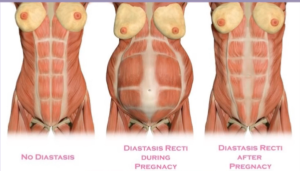07/05/2020
Diastasis Recti: The whys & hows
and when to get it checked.
News Flash! Your Diastasis Recti might be a totally normal occurance, and actually, naturally beneficial.
...Wait....What?
Diastasis literally means separation. Typically, we see a post natal (or any time the belly stretches drastically) dip in the middle of our abdomen on relaxation, and cone shape pop up in a contraction. It’s leftover as your body tries to rebound from extreme stretch. So when you hear someone mention you have a diastasis, all it means is that your abdominal muscles are naturally spacing apart to allow room for you to grow, cool right?
Your abdominal muscles (specifically in this case, the Rectus Abdominis) have two components. The muscles themselves, and the connective tissue that joins them together. With a diastasis, the affected connective tissue down the midline – the Linea Alba – is expanding to allow for growth under the muscles. Explaining it simply, connective tissue (fascia) is designed to stretch in a way that spares muscle fibres. Basically, it’s the failsafe for our abdomen- it’s designed to take all the abuse and protect the muscle.
As your belly grows, every layer- including the muscular layer- needs to expand around the bump. That’s when the connective tissue takes over and expands so muscles don’t have to compromise their integrity. Luckily, our connective tissue stretches long before our abdominal muscle fibres will, and spares them. When the bump disappears, we’re left with sagging tissue- Diastasis.
Diastasis Recti is totally NATURAL, NECESSARY AND NORMAL for growth. Yup, read that again.
It lets the abdomen separate without damaging the muscle tissue (yes, we still need our abs intact and strong in pregnancy, because…well…life?)
So if diastasis is a natural process, why is it a problem?
Actually, research shows that in many women, the connective tissue never actually returns to its pre-pregnancy shape. Diastasis typically reduces to it’s new functional level after the bump disappears (timeline can vary), and having 1-2 finger separation can be totally normal.

So how do you know if what’s left behind is (or is going to) cause a problem?
1. Disrupts your normal strength and function
2. Causes you pain
3. Is anatomically significant (more than 2 fingers- a professional should asses this, as width is not the best predictor)
4. Is NOT going away within a normal time frame. (Pre/Post menopausal women- Listen up!)
If any of these speaks to you, you might be shocked to know that your diastasis is NOT the problem, it’s actually a symptom of something much bigger. It’s also probably time for you to get it checked out by a postnatal specialist who can tell you what your exactly what your body is trying to tell you.
And the best part? It’s probably a totally treatable symptom along with a bunch of other things you’ve chocked up to “ normal mom issues”.
It’s time to get it assessed, diagnosed, and treated properly. A local GrowCo doc, or your pelvic floor PT can help understand and apply the correct body work and rehab techniques!
In health,
DM
 Dr. Deborah Mechanic is a chiropractor,
Dr. Deborah Mechanic is a chiropractor,
and health writer practising in Toronto.
Read more…
Be first to
know.
Join the list for updates, news,
promos, events and more!
Tags:
activity
awareness
body work
diastasis
emotional health
exercise equipment
family
fitness
health
health & wellness
health products
home care
lifestyle
loss and grief
orthopaedics
pain
pain management
pain relief
Patient care
pelvis
postpartum
pregnancy
prenatal
q&a
rehab
treatment
virtual care
wellbeing
Disclaimer: All blog posts on this page are intended information and education only and not advice. If visitors need medical advice or attention, please consult your medical doctor or other medical professional.
Facebook
Twitter
LinkedIn
Pinterest

